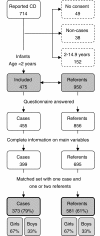Early infections are associated with increased risk for celiac disease: an incident case-referent study
- PMID: 23249321
- PMCID: PMC3560215
- DOI: 10.1186/1471-2431-12-194
Early infections are associated with increased risk for celiac disease: an incident case-referent study
Abstract
Background: Celiac disease is defined as a 'chronic small intestinal immune-mediated enteropathy precipitated by exposure to dietary gluten in genetically predisposed individuals'. Sweden has experienced an "epidemic" of celiac disease in children below two years of age. Celiac disease etiology is considered multifactorial; however, little is known regarding potential risk- or protecting factors. We present data on the possible association between early infectious episodes and celiac disease, including their possible contribution to the Swedish celiac disease epidemic.
Methods: A population-based incident case-referent study (475 cases, 950 referents) with exposure information obtained via a questionnaire (including family characteristics, infant feeding, and the child's general health) was performed. Celiac disease cases were diagnosed before two years of age, fulfilling the diagnostic criteria of the European Society for Pediatric Gastroenterology, Hepatology and Nutrition. Referents were randomly selected from the national population register after fulfilling matching criteria. The final analyses included 954 children, 373 (79%) cases and 581 (61%) referents, with complete information on main variables of interest in a matched set of one case with one or two referents.
Results: Having three or more parental-reported infectious episodes, regardless of type of infection, during the first six months of life was associated with a significantly increased risk for later celiac disease, and this remained after adjusting for infant feeding and socioeconomic status (odds ratio [OR] 1.5; 95% confidence interval [CI], 1.1-2.0; P=0.014). The celiac disease risk increased synergistically if, in addition to having several infectious episodes, infants were introduced to dietary gluten in large amounts, compared to small or medium amounts, after breastfeeding was discontinued (OR 5.6; 95% CI, 3.1-10; P<0.001).
Conclusion: This study suggests that having repeated infectious episodes early in life increases the risk for later celiac disease. In addition, we found a synergistic effect between early infections and daily amount of gluten intake, more pronounced among infants for whom breastfeeding had been discontinued prior to gluten introduction. Regarding contribution to the Swedish celiac disease epidemic, which partly was attributed to concurrent changes in infant feeding, early infections probably made a minor contribution via the synergistic effect with gluten amount.
Figures


References
-
- Dube C, Rostom A, Sy R, Cranney A, Saloojee N, Garritty C, Sampson M, Zhang L, Yazdi F, Mamaladze V. et al. The prevalence of celiac disease in average-risk and at-risk Western European populations: a systematic review. Gastroenterology. 2005;128(4 Suppl 1):S57–67. - PubMed
-
- Mustalahti K, Catassi C, Reunanen A, Fabiani E, Heier M, McMillan S, Murray L, Metzger MH, Gasparin M, Bravi E. et al. The prevalence of celiac disease in Europe: results of a centralized, international mass screening project. Ann Med. 2010;42(8):587–595. doi: 10.3109/07853890.2010.505931. - DOI - PubMed
Publication types
MeSH terms
Substances
LinkOut - more resources
Full Text Sources
Medical

